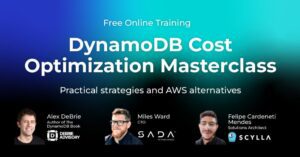Close-to-the-metal architecture handles millions of OPS with predictable single-digit millisecond latencies.
Learn MoreWhat Challenges Prompt Teams to Seek DynamoDB Alternatives?
DynamoDB’s biggest strength is its ability to handle massive amounts of data and traffic. Its pay-per-use model and automatic scaling features are ideal for applications with fluctuating access patterns – particularly when the workload is read-heavy, small in terms of operations per second (ops), or when the data can be confined to a single region.
There are several reasons why teams might look for alternatives to DynamoDB, particularly as they scale application traffic for data-intensive workloads. Here are some common challenges that can lead teams to explore other solutions:
-
- Cost. While DynamoDB is scalable, its pricing structure can be complex, leading to unexpected bills for applications with unpredictable data access patterns. For example, each Read and Write is allocated a cost, with Writes costing significantly more than Reads. Also, to handle the global replication of tables or accelerate the speed of reads and writes to meet SLAs around data throughput rates, there are additional charges for global tables and DynamoDB Accelerator. Teams seeking a more predictable, uniform, and transparent pay-as-you-go pricing model might look elsewhere.
- Performance. DynamoDB was designed and operates on AWS and lacks the same incentives to optimize the use of underlying cloud infrastructure to the fullest extent as many third-party databases are not built by the service provider as the database it runs. For example, ScyllaDB employs a shard-per-core architecture that runs non-blocking, pinned CPU resources in parallel threads, thereby significantly improving performance over and above competing AWS, Google, or Azure equivalent databases designed to run solely on the service provider’s platform.
- Query Flexibility. DynamoDB is designed for fast primary key lookups. DynamoDB Secondary Indexes further magnify costs and may become an impediment for write-intensive workloads.
- Vendor Lock-in. Amazon DynamoDB runs only on AWS, limiting users to a single cloud provider. Even where AWS is the preferred cloud vendor, through mergers, acquisitions, and semi-autonomous departments, there are invariably Google, Microsoft, and other public and private cloud deployments. Options for platform portability are often cited in surveys of developers and IT operations as a critical requirement in the selection and enterprise-wide adoption of cloud databases. As a result, many teams prefer a database solution that is more portable across different cloud platforms.
What Are the Best Alternatives to DynamoDB?
Here are some popular DynamoDB alternatives to consider, each with its own strengths and weaknesses:
Cloud-Based NoSQL Databases
- Azure Cosmos DB (Microsoft) is a globally distributed, multi-model database offering high availability, scalability, and strong consistency guarantees. It is ideal for geographically distributed applications or those needing flexible data models. Azure Cosmos DB provides a CQL-compatible wire protocol but is a Microsoft-only, proprietary offering.
- MongoDB Atlas (Cloud-hosted MongoDB) is a popular document-oriented NoSQL database with a rich query language and a large developer community. It is a good choice for applications that need to store and query complex data structures and run ad hoc analytics. Still, it has difficulty scaling and is expensive for large global deployments.
- Google Cloud Firestore is a flexible, scalable NoSQL document database with offline support and real-time data sync. Firestore is also proprietary—including its APIs—and runs only on the Google Cloud Platform.
- Couchbase is a distributed NoSQL database known for its performance and scalability. It offers strong data consistency and flexible indexing options and runs on multiple cloud and on-premise platforms.
- Amazon Keyspaces (AWS) is the AWS-managed service offering for Apache Cassandra, which is fully compatible with CQL and all the Apache Cassandra ecosystem tools and services. However, Keyspaces does not eliminate the underlying architecture-based inefficiencies of Cassandra being written in Java and node size limitations leading to node sprawl.
- ScyllaDB Cloud is ScyllaDB’s managed service platform and is fully compatible with the Apache Cassandra Query Language (CQL) and the DynamoDB protocols. ScyllaDB is written in C++ and optimized to fully exploit modern cloud infrastructure’s underlying compute, memory, and networking.
What Are Some DynamoDB Open Source Alternatives?
DynamoDB isn’t open-source, but several open-source NoSQL databases offer similar functionality and can be self-hosted as alternatives. Here are a few to consider:
- ScyllaDB is an open-source, high-performance NoSQL database designed for scalability, high throughput, and low latency. ScyllaDB provides a DynamoDB-compatible API (ScyllaDB Alternator), which eases migration from DynamoDB.
- Apache Cassandra is a distributed NoSQL database known for its fault tolerance and ability to handle massive data sets across multiple servers. However, Cassandra underutilizes modern cloud infrastructure and can be more complex to manage than other options, including DynamoDB.
Why is ScyllaDB a Popular DynamoDB Alternative?
ScyllaDB emerges as a popular alternative to DynamoDB for several reasons:
- Cost-Effectiveness. ScyllaDB pricing is transparent and linearly tracks the size of the nodes (based solely on cloud infrastructure consumed) and the number of nodes deployed. There isn’t separate pricing for Reads versus Writes, local versus global tables, additional costs to support higher throughput or any other additional fees. ScyllaDB OnDemand or provisioned offerings can yield significant cost savings compared to DynamoDB’s pay-per-use structure, especially for applications with unpredictable data access patterns. Further, as you scale beyond 50K ops, the cost savings continue to rise.
- Performance. ScyllaDB boasts high performance and scalability, often exceeding DynamoDB in benchmarks. This results in faster read/write speeds, efficient handling of larger data volumes, and sustained lower latencies, usually in the sub to single-digit millisecond range.
- API Compatibility. ScyllaDB Alternator provides a DynamoDB-compatible API. This allows DynamoDB applications to run on ScyllaDB with minimal code changes, reducing migration complexity.
- Flexibility and Control. Since ScyllaDB is open-source, you have more control over the database deployment and configuration. This can be advantageous for tailoring the database to your specific needs and optimizing performance.
- Wider Feature Set. While ScyllaDB offers DynamoDB-like functionality, it has additional features not available in DynamoDB, such as support for larger items and more robust querying capabilities. An added bonus is that ScyllaDB can be used for many other database uses that would map to other AWS offerings.
Where Can I Learn More About Amazon DynamoDB Alternatives?
There are several online resources you can explore to learn more about Amazon DynamoDB alternatives:
- Amazon DynamoDB vs ScyllaDB Comparison. How ScyllaDB’s architecture compares to DynamoDB, including a comprehensive feature-by-feature comparison.
- DynamoDB Migration Case Studies and Best Practices. This is a collection of tech talks, white papers, and on-demand webinars that share why and how teams are migrating from DynamoDB.
- Amazon DynamoDB and ScyllaDB Cost Perspectives. Compares DynamoDB and DynamoDB from a cost perspective.
- Cloud Provider Documentation. Each major cloud provider (AWS, Azure, Google Cloud) offers detailed documentation on their NoSQL database offerings, including comparisons to DynamoDB.
- Database Review Websites. Sites like G2, TrustRadius, and Capterra provide user reviews and comparisons of various NoSQL databases, including DynamoDB alternatives.
- Open-Source Project Websites. The official websites of open-source NoSQL databases like ScyllaDB, Cassandra, and MongoDB offer documentation, tutorials, and community forums to learn more about their capabilities.
- Tech Blogs and Articles. Many technology blogs and publications publish articles comparing different NoSQL databases. Searching for terms like “DynamoDB alternatives” or “Best NoSQL databases for [your use case]” can lead you to helpful resources.
Are there Amazon DynamoDB Alternatives that use the same API?
ScyllaDB with Alternator is an open-source, high-performance NoSQL database designed for scalability, high throughput, and low latency. It offers an “Alternator” feature, which acts as a DynamoDB-compatible API. This allows DynamoDB applications to be run on ScyllaDB with minimal or no code changes. ScyllaDB boasts advantages like lower costs and improved performance compared to DynamoDB. There are options for self-management of the database infrastructure on-premise or in a private cloud or to run it as a managed service on AWS or Google Cloud platform.

NoSQL Masterclasses: Advance Your NoSQL Knowledge
Looking for extensive training on data modeling, database migration, and high performance for NoSQL Databases? Our experts offer 3-hour masterclasses that assists practitioners wanting to migrate from SQL to NoSQL or advance their understanding of NoSQL data modeling. These free, self-paced courses cover techniques and best practices on core NoSQL concepts.
